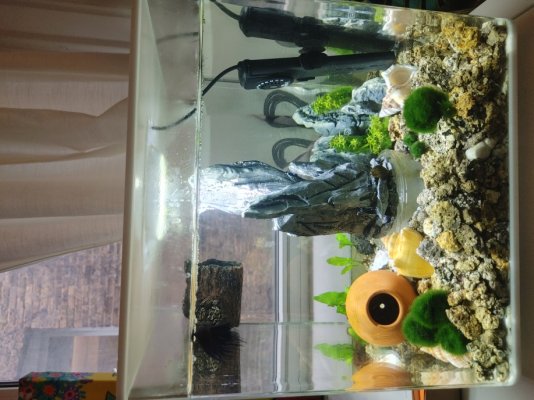I bought an 8 gallon biorb cube for my daughter at Christmas (not knowing that people generally dislike them) and added one betta and a snail. I read up on cycling and thought my tank was cycled by mid February. Then at the end of April my ammonia starting spiking, a lot. Soon it was going from below .25ppm to nearly 1ppm over a couple days. I've done countless water changes since this started, with vacuuming, but it always goes back up again quickly. I do get significant amounts of nitrates after the spikes (although not a lot of nitrites), so I assume my bacteria are working. The tank is really clean. I've added new bacteria. I also tried using Ammo Lock for a while. Nothing is fixing this and now I'm totally out of ideas about what could be happening.
And, on the advice of everything I read, I wasn't changing the filter, but just cleaning it in used tank water. But then I read that sub-gravel filters like these actually must be changed because they store so much waste that if left unchanged they eventually create ammonia spikes. So five days ago, when the level was at about 1ppm again, I changed the filter, and the airstone. There are a lot more bubbles now than before, so maybe something was clogged. In any case, The next day the ammonia was nearly zero, but today it is again at nearly 1ppm.
I'm totally exasperated.
Other info:
-Tank temp is 80 degrees
-I seem to have really hard water. I did a KH and GH test, showing 3 and 19 respectively.
-My PH was around 6.5 when I started seeing this issue, which seemed low. I found that the filtered water I was using was 6.5 but my regular tap was about 7.6, so I started using that for water changes instead, always with Prime. My PH is now around 7.6.
-I've tested my tap water. No ammonia there.
If anyone with more experience is willing to share their advice, I would be really grateful!
Thank you.
Attaching a photo of the tank in case it's helpful.
And, on the advice of everything I read, I wasn't changing the filter, but just cleaning it in used tank water. But then I read that sub-gravel filters like these actually must be changed because they store so much waste that if left unchanged they eventually create ammonia spikes. So five days ago, when the level was at about 1ppm again, I changed the filter, and the airstone. There are a lot more bubbles now than before, so maybe something was clogged. In any case, The next day the ammonia was nearly zero, but today it is again at nearly 1ppm.
I'm totally exasperated.
Other info:
-Tank temp is 80 degrees
-I seem to have really hard water. I did a KH and GH test, showing 3 and 19 respectively.
-My PH was around 6.5 when I started seeing this issue, which seemed low. I found that the filtered water I was using was 6.5 but my regular tap was about 7.6, so I started using that for water changes instead, always with Prime. My PH is now around 7.6.
-I've tested my tap water. No ammonia there.
If anyone with more experience is willing to share their advice, I would be really grateful!
Thank you.
Attaching a photo of the tank in case it's helpful.

